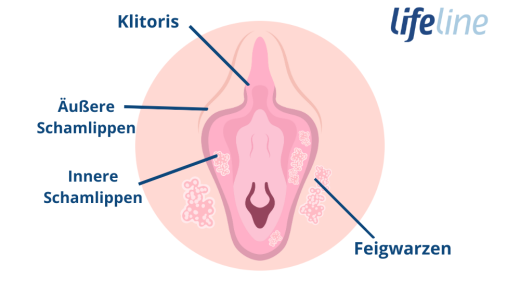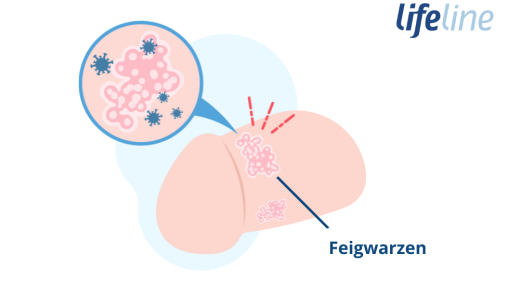Genital warts are benign skin growths in the intimate area or, more rarely, in the mouth. They are caused by human papilloma viruses (HPV), which are primarily transmitted through sexual intercourse. How do genital warts differ in men and women and how can they be removed?
- © polkadot – stock.adobe.com
Quick overview
Symptoms: Genital warts are small, pointed warts that usually have a jagged, cauliflower-like surface and sometimes spread over a large area. The warts can itch and ooze, but rarely cause pain.
Cause: Genital warts are caused by human papilloma viruses (HPV). Most people become infected through sexual intercourse.
Treatment: There are various creams and gels for treating genital warts. However, depending on the location and severity, surgical removal or icing is also possible.
Prevent: Condoms can minimize the risk of contracting genital warts. The HPV vaccination also offers protection.
Article content at a glance:
What are genital warts?
Genital warts (condylomata acuminata, pointed condylomas) are among the most common sexually transmitted diseases. The pointed or cauliflower-like warts occur primarily in the anal and genital areas – which is why they are often called genital warts. In rarer cases, they can also occur in the mouth and throat. Genital warts do not cause pain, but can itch and secrete a foul-smelling secretion or bleed.
It is estimated that around one percent of all sexually active men and women between the ages of 18 and 49 have genital warts. The 20 to 24 year old age group is particularly affected.
Transmission of genital warts and HPV
Genital warts are caused by human papilloma viruses (HPV). There are many different types of HPV. Some can also cause certain types of cancer, such as cervical cancer or anal cancer. Subtypes 6 and 11 are predominantly responsible for genital warts.
The viruses are transmitted through close physical contact with infected people, usually during sexual intercourse. The pathogens enter the body through the smallest injuries in the skin or mucous membrane.
Less commonly, sharing objects that have come into contact with infected areas of skin leads to genital warts. Such smear infections can occur, for example, when the same towel or sex toy is used. Pregnant women can pass the HP virus to their child during birth.
Genital warts: symptoms in men and women
In most cases, an infection with genital wart viruses goes unnoticed. Only a few affected people experience symptoms four weeks to eight months after infection.
Typical symptoms of genital warts are:
- small nodules in the genital or anal area, rarely in the mouth and throat
- isolated or bed-like skin growths (cauliflower-like structures)
- usually whitish in color, but can also vary from gray-brown to reddish
- occasionally itching, burning, oozing
- Genital warts can bleed
- usually no pain
In five to ten percent of those infected with HPV, the disease takes a so-called subclinical course. This means that skin reactions occur as a symptom of genital warts, but these are not visible to the naked eye and therefore usually go unnoticed.
-

© Pepermpron/Lifeline
Genital warts in women
In women, genital warts are most commonly found on the vagina and labia. But they can also occur in the rectum area. Infection of the urethra and anus is also possible. Genital warts can also form on the cervix. There is an increased risk of developing malignant tumors.
-

© Pepermpron/Lifeline
Genital warts in men
In men, genital warts usually appear on the shaft of the penis, the foreskin, the foreskin frenulum or the scrotum. They can also spread into the urethra or rectum.
Diagnosis of genital warts
A close examination and palpation of the genital area are often sufficient to diagnose genital warts. A magnifying glass is usually used. In addition, a mirror image of the rectum or anus can be helpful.
Smaller condylomas can also be made visible with acetic acid. They turn white when you dab them with it. This is primarily done when genital warts are to be surgically removed.
If these measures do not produce a clear diagnosis, the doctor will take further steps, such as microscopic examination of tissue samples.
If the diagnosis of genital warts is confirmed, tests will be carried out for other sexually transmitted diseases offered, particularly syphilis and HIV. A blood test is necessary for this. In addition, if the result is positive, the partner should also have themselves examined.
Therapy: This is how genital warts are treated
The treatment of genital warts depends primarily on the number, size and location of the warts. Creams or solutions are often used for self-treatment. But surgical removal is also possible.
Home remedies for genital warts?
Since genital warts can multiply quickly and are contagious, home remedies such as tea tree oil or apple cider vinegar are not recommended. Their effect has not been scientifically proven and does not replace medical treatment!
Creams and ointments for external genital warts
When treating warts with medication, solutions, gels or creams with active ingredients such as:
- Podophyllotoxin
- Imiquimod
- Green tea dry extract
The products all require a prescription and must be applied regularly over several weeks. The exact application depends on the doctor’s instructions or the information in the package insert.
Another drug treatment for genital warts is the application of trichloroacetic acid. The strong acid can only be used by doctors and has the disadvantage that it burns and hurts when dabbed on. The advantage of this therapy against genital warts, however, is that it works particularly well on small genital warts on the mucous membranes. It can also be used on pregnant women.
Freeze genital warts
Another procedure is cryotherapy. This is a cold application: liquid nitrogen is sprayed or dabbed onto the warts. This treatment is also repeated weekly or fortnightly.
Surgical therapy procedures
Alternatively, genital warts can also be removed surgically. There are various procedures that have one thing in common: local anesthesia necessary is. In the case of recurring acute condylomata or extensive, bed-like infestations, removal by laser or electrocautery – a device with a thin wire loop that is heated by electricity – is recommended as treatment.
Course: Genital warts can recur
Genital warts are harmless but stubborn: in around 30 percent of cases, they come back despite apparently being completely removed. That can have several reasons:
- small, hidden warts were overlooked
- the infected tissue was not adequately treated
- a new infection occurs in the partner
Due to frequent recurrences, regular follow-up examinations after successful genital wart treatment make sense.
Preventing genital warts: How to protect?
To prevent genital warts, it is important to avoid infection with human papilloma viruses (HPV). Using condoms or femidoms during sexual intercourse does not offer reliable protection, but it can at least reduce the risk.
HPV vaccination
For several years now, there has been another way to prevent genital warts: the HPV vaccination. The vaccine not only protects against HP virus types 16 and 18, which can cause cervical cancer, but also against HP viruses types 6 and 11, which are responsible for the development of genital warts.
However, even vaccination does not offer 100% security, as in rare cases other HPV types can also cause genital warts.


